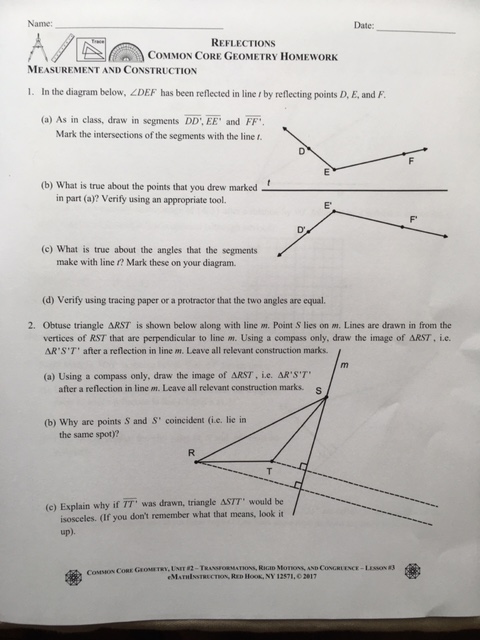The summer has begun and so I have begun my work in earnest on eMATHinstruction’s Common Core Geometry. I have wanted to write a text on Geometry for about as long as I could remember, but things just kept getting in my way (kids, teaching, algebra… you know, life).
Geometry is an interesting subject that has been studied for almost 3,000 years. Let that one sink in. Three thousand. Euclid’s Elements is regarded as one of the most important books ever written, and he composed that little tome about 2,400 years ago. And, yet, why do we study geometry? We can cite art and architecture, trigonometry, and measurement as needing geometry. But, still, why proof? Why axioms? Why the endless emphasis on terminology, theorems, and corollaries? Dr. Piers Bursill-Hall of the Cambridge Faulkes Institute for Geometry (yes that exists) said it eloquently:
“Since the ancient Greeks, geometry has been the paradigm of truth and ordered knowledge, of clear thinking and the rigor of absolute precision of thought. But, it’s real power is that it is also about the world around us. It seems that one of the most fundamental of human scientific intuitions is that the physical world is ultimately geometric and that to study geometry is in some sense to uncover some kind of ultimate essence of the physical world around us.”
Wow! Go Piers!!! I know even asking the question might seem a bit odd, given that we all studied geometry on our way to becoming math teachers. But, unlike algebra, much of geometry faded for me as I pursued my studies in higher-level math.
Add to that question, the confusion that comes from changes to the way we think about a Geometry course given the Common Core Standards, and I wanted to think hard about this course before I started writing. I love, love, love geometry and want to write its story in a way that engages kids and teachers. A way that is hands-on and accessible to all students, including those with disabilities. But, whatever this course will become must also meet those Common Core Standards as outlined by the PARCC organization (and “clarified” by various state agencies like NYSED).
Now, much of geometry in the Common Core hasn’t changed, but a very new piece of it is the emphasis placed on using transformations to establish congruence and similarity. Not just establish, but define congruence and similarity. This is all based on the wonderful work of Hung-Hsi Wu, of U.C. Berkley. If you want to really understand geometric thinking based on transformations, you need to read his works, especially Teaching Geometry According to the Common Core Standards. I’ve digested two of them (around 150 pages each) in the last few weeks.
I’ll be incorporating his ideas as well as classic Euclidean and Cartesian geometry into one large picture. I’ve already made progress and am hoping to release the first three units of the course by mid-August. Then, I will continue to post new material in rough draft form as the year progresses. There will be no products (answer key subscriptions and workbooks) for sale until the Spring of 2017, but there will be plenty to look at and use.
A warning to all geometry teachers, though: this course will require extensive use of rulers, protractors, compasses, and tracing paper. That’s just the deal with geometry. It’s hands-on; it’s interactive; it’s tactile. On each lesson and homework sheet, I’ll put icons that quickly show which geometer’s tools are needed. Don’t worry, we will be offering easy to use tracing paper in our eMath Shop eventually.
And it should be the funnest math class a kid takes. In my humble opinion, at least.
Here are some pictures:



